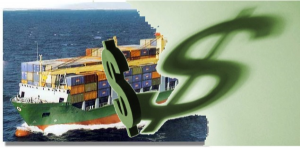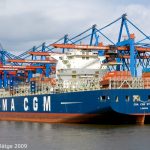What’s Happening With International Shipping Freight Rates?
 For years now, we’ve talked about overcapacity plaguing carriers in the international shipping industry and putting downward pressure on freight rates. Over the last couple years, freight rates hit record lows. Shippers have been in a position to take advantage of low freight rates while carriers suffered huge losses. But what about now?
For years now, we’ve talked about overcapacity plaguing carriers in the international shipping industry and putting downward pressure on freight rates. Over the last couple years, freight rates hit record lows. Shippers have been in a position to take advantage of low freight rates while carriers suffered huge losses. But what about now?
What are freight rates doing in 2017?
Overcapacity is certainly not gone. It will likely be a few years before capacity and demand reach a balance. The earliest projections I’ve seen for demand meeting capacity is 2020. However, I’ve also heard projections of overcapacity not being under control until 2025.
That being said, ship scrapping is up while ship ordering is down. Carriers also could, in theory, dock ships like they did in 2010 in order control capacity and relieve the downward pressure on freight rates caused by overcapacity.
Global trade is showing signs of health and could always grow more than economists project. Or less. After all, much slower global trade growth than economists projected played a big role in carriers facing the overcapacity they’ve struggled with for the last several years.
All this is to say, no one can really point to a specific year and say that is when overcapacity will definitely end in the international shipping industry, but most think overcapacity will still exist for at least a few more years.
However, while overcapacity is still here, record low freight rates are not.
Carriers would certainly like to see it happen faster, but freight rates are rebounding. Right now, U.S. importers are paying significantly more to import goods from China, and the rest of Asia, than they were a year ago.
According to a Journal of Commerce (JOC) article by Bill Mongelluzzo, this week’s transpacific spot rates are 49% higher to the East Coast and 74% higher to the West Coast per FEU than they were a year ago.
Despite the fact that freight rates are significantly higher than a year ago, Mongelluzzo does report that freight rates are currently dropping. “…spot rates this week dropped 6 percent to the East Coast and 9 percent to the West Coast,” Mongelluzzo wrote. “This week marks the third consecutive week of declining rates.”
This is actually the typical behavior for transpacific freight rates this time of year. Mongalluzzo says as much, reporting that U.S. import freight rates from Asia “returned to market fundamentals”.
The international shipping industry, and the freight rates within it, are always volatile. There are plenty of variables that factor into it, including but not limited to capacity, demand, oil bunkers, market perceptions, seasonal behaviors, labor issues at ports, congestion, disruptions, and strength of economies. Even one time situations, like the worry about disruptions from the April 1st launch of the current carrier alliance situation, can affect shipping decisions and the freight rate market.
Despite all the factors that make freight rates and the international shipping industry in general volatile, there are normal ebbs and flows. For example, shipping volumes along with freight rates increase for U.S. shippers when big shopping seasons like back to school and the holidays approach. Volume and rates tend to lower between these types of seasons, at times such as now.
2017 looks to be following the “normal patterns” of ebb and flow and projects to continue to do so, with peak season coming up in a couple of months. But it’s following those patterns at a higher freight rate level than last year.
This is good news for carriers trying to recover.
Bruce Barnard reported in the JOC that the world’s third largest carrier by capacity, CMA CGM managed to return to making a profit in the first quarter of 2017. The “return to the black” is attributed to higher freight rates and the acquisition of APL.
This was the first time since 2011 that now CMA CGM’s APL unit posted a profit, according to Barnard.
Not all carriers managed to make a profit in the first quarter of 2017, despite increased freight rates from last year. In fact, we already posted about the top dog of the carriers, Maersk, posting a loss of $66 million in the first quarter.
It would certainly be premature to say carriers have recovered from years of low, low freight rates. However, freight rates are getting healthier for carriers. Of course, that means more expensive for shippers.
However, freight rates are still much lower than carriers would probably like. After record low freight rates, it would be hard to imagine not seeing a rise in year over year rates. But it will have to be seen if carriers can manage to keep rates increasing and stay on track for eliminating their overcapacity problem.





Jared, the carriers are doing their typical “raise rates today, lower them tomorrow and the next day and the next.” The spot market rates
TPEB are higher than a year ago, but they could be higher. They aren’t for two reasons; carriers continue to chase market share instead
of profitability, despite what Mr. Saade says. On supply/demand they can easily control that but won’t. Recall the end of 2009 and into 2010
when the industry anchored over 600 vessels and the industry went from loosing $21. Billion in 2009 to making $8. Billion in’2010. And of
course they have never repeated that and lost money six straight years.. So for the most part, freight rate levels are a series of self’
inflicted wounds by carriers actively supported by BCO’s who have objectives of lowering costs annually.
The depiction of the rate levels is accurate, but the comment that the rates are lower than the carriers would like is a huge understatement..
The facts are that with the consistent low rates for 6 years we, had the tumultuous 2016 with mergers, acquisitions and a failure of one
line. Shippers complained about services years ago; slow steaming, increased transit times, increasing inventories. Now it is going from
4 Alliances to 3, fewer options, some changes in port calls, less frequency, fewer direct calls. Logically, what can they expect? An industry that
has lost money 6 years in a row totaling in the Billions of dollars, the shippers are getting what they pay for – mediocre to poor services and
fewer carriers to deal with.
Is that the world they want to be in constantly? If the objective is constant low rates they will wind up with very few carriers and choices and services
will not improve without increased rates and a return to profitability for the industry. Until then, a few gains here and there by efficient carriers but
with little or no consideration of the shippers – the shippers have none for the carriers, They want constant low rates AND vastly improved services. Ain’t
going to happen.